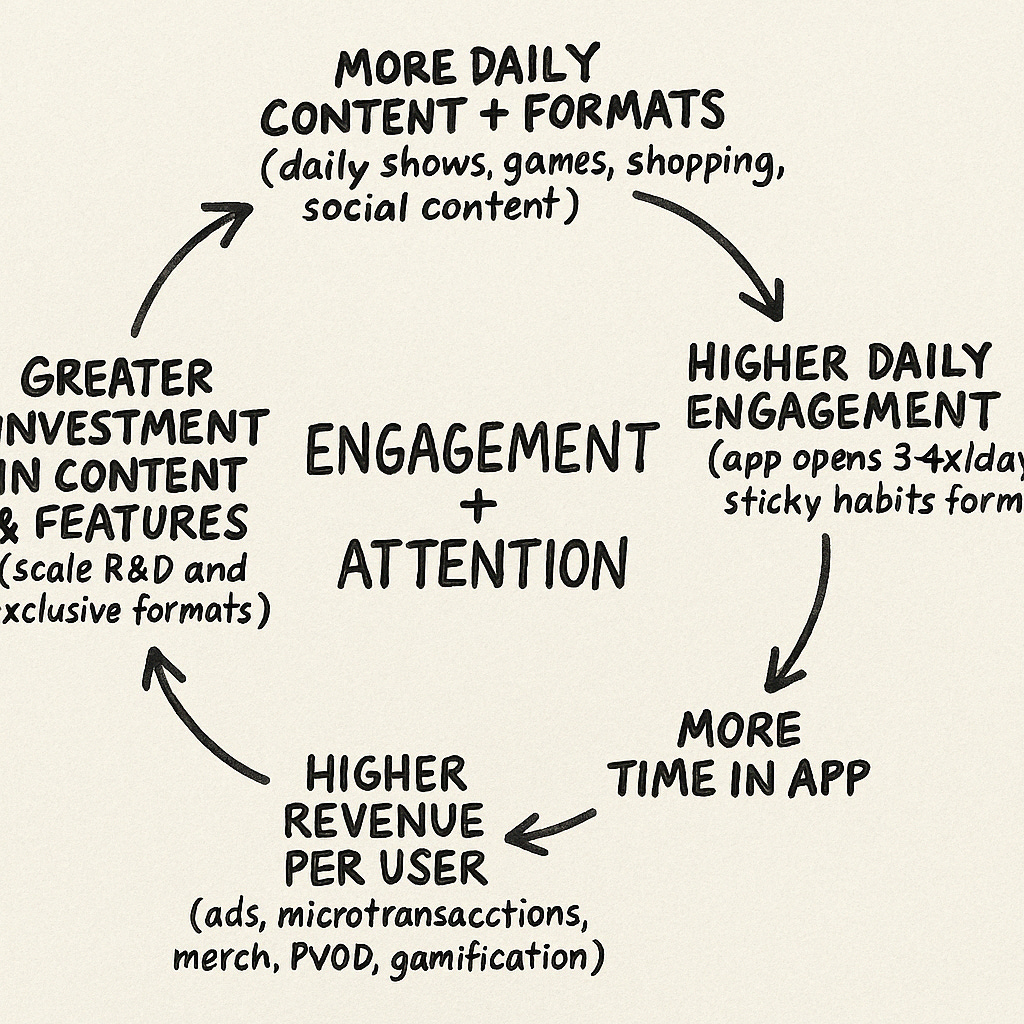Welcome to the SVOD Super App Era
Why the next phase of streaming isn’t TV—it’s a platform war.
All art aspires to the condition of music, said Walter Pater. And perhaps we can also say that all apps aspire to the condition of China’s WeChat, which is not only China’s leading texting app, but also its leading social network and payments platform.
Despite frequent past disruption, there’s some tendency to believe that today’s version of Hollywood is going to be pretty stable from here on out. I’m here to suggest that this is not likely. The future will not be Netflix with more shows. It will be something new.
In the next wave, the most important metric for major streamers won’t be subscribers, it will be churn (how often people cancel) and daily engagement. So the next evolution of the streamer will inevitably do more — it will be part TV, part Facebook, part Wordle, part shopping mall: a daily, habit-forming experience that spans video, games, AI characters, social interaction, and commerce.
Let’s walk through why and what that could mean.
What Changed
In the early days of SVOD, the playbook was simple: make a handful of great shows, win awards, gain audience. That got you to 30 million or so subscribers.
Once services hit 60 million, 80 million, or 200 million subs—and especially once ad-supported tiers became the growth engine—the game shifted.
Now, growth is slowing. Most U.S. homes already have three or more streamers. Churn is the issue.
So the goal is no longer just acquiring customers—it’s keeping them and making them more engaged. That means driving more hours per day, more app opens per user, more reasons to come back. If you’re not generating three or four meaningful notifications per day, maybe you are falling behind.
New Formats for New Habits
To thrive in this new reality, streamers will look for formats that support frequent, habitual engagement, year round. Here are two formats that could thrive in the Super App Era:
The Serial Movie Franchise
Think M3GAN—but part two drops in three months, and part three three months after that. Or imagine Jack Ryan delivered as four films per year, like seasonal chapters in a franchise novel.
The idea is to blend the narrative power and production cadence of television with the event value of film. When you commit to the first one, you have to commit to two or three follow ups which are quickly shot in a series fashion.
This format is riskier upfront—streamers and producers must commit to multiple films before the first has proven out—but the reward would be increased anticipation, reduced churn and some eventizing of the slate. You replace the series finale with ongoing anticipation.
The All Year Series
What if a show never ended?
Picture Billions or X-Men reimagined as an open-ended, 52-week narrative. The cast expands. The storylines multiply. You follow different factions or characters, and each week brings a new episode from somewhere in the world.
The economics could be serious: a $7 million-per-episode show running once a week for 52 weeks costs $364 million per year. Or $500K per episode every weekday is still $130 million annually.
But if the result is a show that becomes part of people’s weekly rhythm the payback is real.
As engagement becomes the key priority, we might expect things like soaps, (more) reality, talk shows, and maybe news. As Gen Z focuses more on short shorts and as Chinese shorts apps like DramaReel gain momentum, no doubt some percent of programming will be shorts. (Was Quibi just ahead of its time?)
The Social Layer
Where this gets especially potent is in the social feedback loop.
Right now, most streaming apps are silent. You watch a show and close the app. But in the next phase, the goal will be persistent engagement—just like Facebook, Reddit, or TikTok.
Expect to see:
Comments, likes, and reactions inside the app
An AI asking what you’d like to see and how your day is going
Incentives for interaction: badges, leaderboards, early access
You finish The Boys, and the app notifies you that 3,000 people liked your comment. You comment again. You watch the teaser for next week. Now it’s 10pm and you’re still in the app.
If anyone is still up for “the metaverse,” you could then have friends over to your virtual apartment in Netflix City.
This layer makes streaming sticky.
AI Characters, Games, Notifications, and Friends
In the future, your streaming app may include characters you can talk to.
Some will be AI companions: a coach, a gossip partner, a game show host, a digital friend. Others may be actual characters from your favorite shows, available for short interactions: a pep talk from Geralt of Rivia, dating advice from a Bridgerton, or fashion tips from your Emily in Paris AI twin.
They might message you. They might know your watch history. They may suggest what to watch—or what to buy. They might even tell you that your last purchase was “smart.”
It sounds strange. But it won’t feel strange for long.
Netflix has already started on games.
Shopping and the Mallification of SVOD
Live shopping segments, hosted by personalities or AI — its big in China
In-character hosts demoing outfits, collectibles, or home goods
Merch, bundles, and digital goods personalized to your profile
Rewards for watching or sharing, redeemable in-app
It’s not hard to imagine Netflix as a platform where your favorite Stranger Things character sells you a limited-run hoodie—or an AI-voiced message for your birthday.
In this environment, content, commerce, and community blur into one experience.
What This Means for Streamers
As I discussed here, this model favors scale.
Mid-tier services will struggle to meet this challenge. Max, Peacock, and Paramount+ were built for the boutique era. They may need to shift to licensing, or become branded channels inside bigger ecosystems—Amazon Channels 2.0.
In general, mid-sized services will either go niche and lean or be absorbed.
Key Opportunities
What are the opportunities in this new world, aside from creating a super app?
Be talented and unique
As always, talent wins. A great voice, an original sensibility, or the ability to do something no one else can still cuts through—even in an AI-saturated, engagement-maximizing landscape.
But get it out there — you have to build your brand.
Build IP online
Creators who can seed characters, story worlds, or aesthetics online—whether through webcomics, shorts, podcasts, or even memes—can build real followings before the studios ever call.
Once you’ve proven concept and traction, you are holding real value.
Create a platform for decentralized content funding
If people are going to build IP independently online, they will need a way to finance this activity. There’s a growing opportunity to build the first real capital market for digital-first IP, a place where fans and investors can fund creative projects—across film, TV, games, podcasts, animation, and more using tokenized securities.
Think AngelList meets Kickstarter meets NASDAQ.
Big streamers will always want things that have built in audience, so producers and creators will increasingly try to build IP on their own and this will be an economically viable way to develop.
Build the alternative
Not everything will be a super app.
There’s probably room for a curated, high-quality boutique streaming platform: something like Criterion meets A24.
The pitch: We’re not the mall. But we have the smartest shows and films. Whether these platforms can attract the strongest creators indefinitely remains to be seen—but the ones that do will punch far above their weight.
Hollywood's Platform Endgame
Streaming is now competing with social platforms—X, TikTok, Facebook. Those are the apps people already open 10 times a day. Those are the places where entertainment and interaction are fully integrated.
It's worth noting that social networks tend toward monopoly in each category. People don't want to be split across five platforms—they want to be where everyone else is. That gravitational pull toward one dominant platform applies here too. If streaming becomes social, interactive, and habit-based, it may also become winner-take-most.
The streaming wars were merely the opening skirmish. The platform wars will determine not just what we watch, but how we connect, shop, and even form our identities online. And unlike traditional Hollywood, where a handful of studios could comfortably coexist for decades, the economics of engagement platforms suggest there might ultimately be room for just one or two winners.
Looking at today's players, the winner isn't obvious. Netflix has the subscriber base and global reach, but lacks social DNA. Disney has beloved IP but struggles with technology and seems to suffer from a substantially diminished ability to launch new properties. Amazon already blends commerce and content (and owns Twitch) while Apple has the ecosystem integration. Meanwhile, TikTok and Meta hover on the periphery with engagement expertise but content gaps. The most dangerous player might be one we're not watching closely enough—perhaps a gaming platform like Epic or a YouTube that decides to grow in this direction. And if TikTok really changes hands, that could be an important acquisition.
We'll likely see the first semi super app emerge within 24-36 months. But by 2030, we'll wonder how we ever tolerated the passive, siloed streaming experience of 2025.
For executives, creators, and investors in this space, the implications are clear: betting everything on the current model is fighting yesterday's war. The opportunity lies in building the new experience, including content, community, and commerce.
The question isn't whether you'll subscribe to a super app—it's which super app will get your attention, your social graph, and your entertainment budget. For Hollywood, it's existential: evolve beyond content into experience, or become merely a supplier to the platforms that do.
For next time: is there something that could prevent this outcome? What is the alternative?
Roy Price was an executive at Amazon.com for 13 years, where he founded Amazon Video and Studios. He developed 16 patented technologies. His shows have won 14 Best Series Emmys and Globes. He was formerly at McKinsey & Co. and The Walt Disney Co. He graduated from Harvard College in 1989.







The hallmark streaming service offers points for viewing.
Not sure what they’re redeemed for, my wife is vague about that part 😁